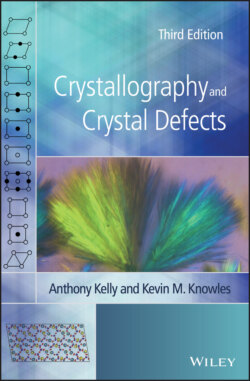Читать книгу Crystallography and Crystal Defects - Anthony Kelly - Страница 43
2.12.2 Glide Planes
ОглавлениеThe operation of glide plane repetition is shown in Figure 2.22c. Again, the magnitude of the translation will be of the order of the lattice parameters. Macroscopically, the glide plane in Figure 2.22c would show itself as a mirror plane.
Glide planes are described as axial glide planes if the translation parallel to the mirror is parallel to a single axis of the unit cell and equal to one‐half of the lattice parameter in that direction. Such glide planes are given the symbols a, b, or c, corresponding to the directions of the glide translations. A diagonal glide plane involves a translation of one‐half of a face diagonal or one‐half of a body diagonal (the latter in the tetragonal and cubic systems), and is given the symbol n. A diamond glide plane, given the symbol d, can only occur in orthorhombic F, tetragonal I, and cubic I and F lattices. In orthorhombic F lattices, this involves a translation of one‐quarter of a face diagonal, whereas in the tetragonal and cubic lattices this involves a translation of one-quarter of a body diagonal.
